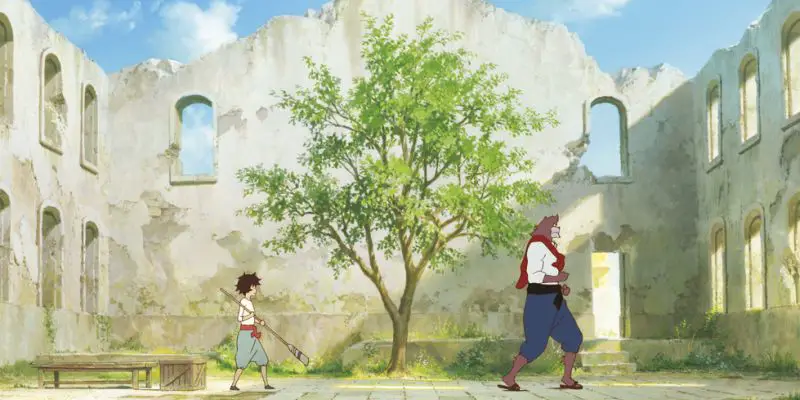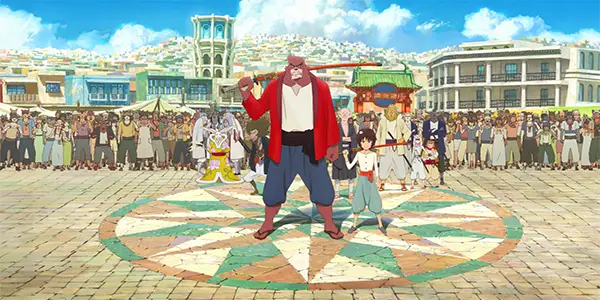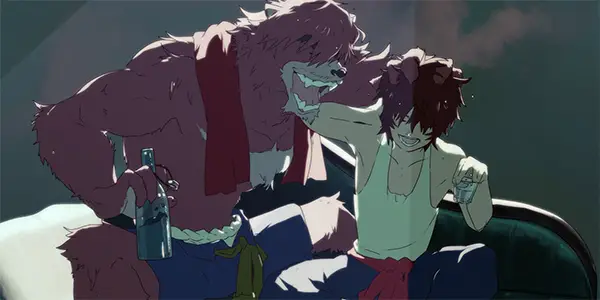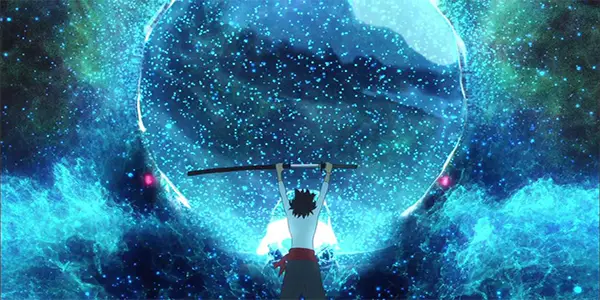THE BOY AND THE BEAST: The Power of a Well-Told Story

Sterling is the son of famous luchador El Vaqueiro Nero.…
Bakemono no Ko, translated as Monster’s Child, is making its English run under the name The Boy and the Beast. It is a gorgeous-looking film, but what separates it from the rest of the disposable moving images we’ve been subjected to this year is the grace with which it tells its story. I have been to the theaters a lot this year, but I have only been brought to tears a few times.
This film is the latest offering of Japanese animation this year, filling a void left in American hearts since the recent retirement of Studio Ghibli co-founder Hayao Miyazaki. For those viewers who are not amine-philes and do not seek out animated works from overseas, it is quite likely that the majority of anime films seen in a theater probably come from Studio Ghibli: Ponyo (2008), Spirited Away (2001), Princess Mononoke (1997). Now, enter Mamoru Hosoda.
Hosoda comes from work in Japanese television. He spent the early part of his career on the animated shows Dragon Ball-Z and Sailor Moon. These shows should be familiar to most children who grew up in the 90’s. (My roommate in college still watched Dragon Ball-Z as a yearly ritual.)
Hosoda was then tapped to direct the Digimon movies. Digimon, a portmanteau of digital and monsters was an updated Pokemon. I remember Digimon the show and I recall the movie having a limited release. Yet, having heard of all of these television and marketing entertainment pieces, I had not heard of Mamoru Hosoda. His venture into more thematically complex animated works gave us Summer Wars (2009) and Wolf Children (2012). Both films slipped under my radar.

Now, with The Boy and the Beast, Hosoda has seared himself into my psyche. Perhaps literally, as the film begins with a kung-fu ballet depicting figures of pure fire staged against a black void. This sequence, which serves as an exposition to the politics of the Beast Realm, is so dazzlingly animated, with the flaming characters dancing and careening along every possible axis of motion, that I had to check to confirm that someone had not slipped 3D glasses over my eyes without my knowledge.
The Story in a Nutshell
The exposition sets up this: There is a Beast Realm that exists parallel to our own Human Realm. In the Beast Realm, there is a Lord who keeps order. Every so often, the God is granted a chance at being Reincarnated into the Human Realm. This is the situation at hand when the film picks up; naturally, one of the beasts must ascend to the role of Lord of the Realm.
Iōzen, a noble beast and master of the martial arts, is the obvious nominee for Ascension. However, Kumatetsu – the beast on the film poster, and whom I suspect was based on a conglomeration of the works of Ron Pearlman – is just as skilled at martial arts and challenges Iōzen’s nomination. The Lord, seeing potential in the flawed Kumatetsu, postpones the match between the two beasts until Kumatetsu can demonstrate that he is a worthy opponent: he must take an apprentice.

The story then jumps into the Human Realm, where nine-year-old Ren sits alone. His mother, whom he has lived with since his parent’s divorce, has just died. With no news from his estranged father, Ren is assigned to live with distant relatives. Ren runs away instead, filled with hatred. He is eventually discovered by Kumatetsu and lured into the Beast Realm, but not before leaving a ghost behind: the ghost of his hatred and loss.
From here we see the struggles of Ren and Kumatetsu as they learn to co-exist, train, and eventually heal, with each other. Of course, while things are sorting themselves out in the Beast Realm, Ren’s trauma still waits for him back in the Human Realm. It is how the film deals with Ren’s return home that elevates the material beyond being an eye-candy, popcorn flick.
The Incredible Animation
I have already gushed over the animation in the opening sequence of Bakemono no Ko. Let the reader be assured that the animation continues to dazzle throughout. The district of Shibuya is crafted with care, morphing from a claustrophobic, ultraviolet nightmare when Ren is nine into a quiet modern province up his return. Without it ever being mentioned, one can feel the global recession that must have occurred during Ren’s absence.
The Beast Realm is laid out in rich earth tones and warm notes. Here the animators get the opportunity to play with physical comedy and action. When the Moby Dick inspired – yes, you read that right – resolution begins, the audience realizes the animators have been restraining themselves. In this sequence, they pull out all the stops, mixing CGI and hand-painted images together to breathtaking effect.

There have been great achievements in animation since the creation of Gertie the Dinosaur in 1914. However, there is something to the way the Japanese animate that so effectively renders the light and shadow of the world we see. In Bakemono no Ko, the animators ramp up their highlights slightly, giving the frame a glowing quality that the eyes drink up when viewing in a dark theater.
Something must be said for the animators’ intuitions toward sensing when to omit details. There is such loving attention paid to detail in some scenes, while other frames will confidently represent the characters with the most basic doodle. This withheld detail adds another spatial dimension to the frame besides the x,y, and z axes. The viewing eye is able to separate information based on the emphasis inherent in the animated cell.
I haven’t always been a fan of Japanese animation; the cartoon faces would often make me uncomfortable. I have come to realize that the animators are using exaggeration and expressionistic techniques to visually represent a character’s emotions. It’s no wonder this island nation brought us the emoji.
Story: Why We’ll Still Be Talking About This Film
Animation alone cannot hold a movie. I have seen plenty of gorgeous films fail due to a poorly conceived story, or lackluster pacing. Bakemono no Ko falls into neither trap. The story is not something we’ve never experienced before. In fact, it is a pretty standard Iron John-esque coming-of-age tale. However, the devices used in the film, the magic and literary allusions, and the earnestness with which the characters’ flaws are addressed, make the film a wonderful addition to the genre.
In terms of pacing, Bakemono no Ko wastes no time. The first act rages by like a thunderstorm on Adderall. When we get to act two, the film allows breath – especially upon Ren’s return to Shibuya – but it never wastes our time, nor allows the audience to get ahead of the story. Come act three, though there are perhaps six story elements up in the air, the film deals with each conflict without dragging in pacing, or shortchanging the resolution.
Bakemono no Ko, or Monster’s Child, or The Boy and the Beast, is one of the best animated films I have seen in the last five years, I’d put it up there with the finest offerings from Studio Ghibli or Pixar. It sets up relatable conflicts and then works through them with inventive imagery. In sorting through its conflicts, the film plays like a fantastic, coming-of-age martini: two parts The Lion King, one part The Karate Kid, stirred three times with the brush of a great animator, and garnished with an olive taken from the set of Good Will Hunting.
Borrowing from ingredients like that, and with the skilled Mamoru Hosoda as a bartender, the c*cktail on screen is marvelous. I left the theatre on foot on a crisp evening – I walked home light-hearted, transformed, smiling at everything and nothing. That’s what great stories can do.
What animated stories have stuck with you through the years? Were any of them from Studio Ghibli? Share your thoughts in the comments section!
Does content like this matter to you?
Become a Member and support film journalism. Unlock access to all of Film Inquiry`s great articles. Join a community of like-minded readers who are passionate about cinema - get access to our private members Network, give back to independent filmmakers, and more.
Sterling is the son of famous luchador El Vaqueiro Nero. After his father grew ill, he took up the family business. However, he was publicly unmasked in 2005, during a match in Hermosillo. Bringing great shame to his family line, he now works in the film industry.













